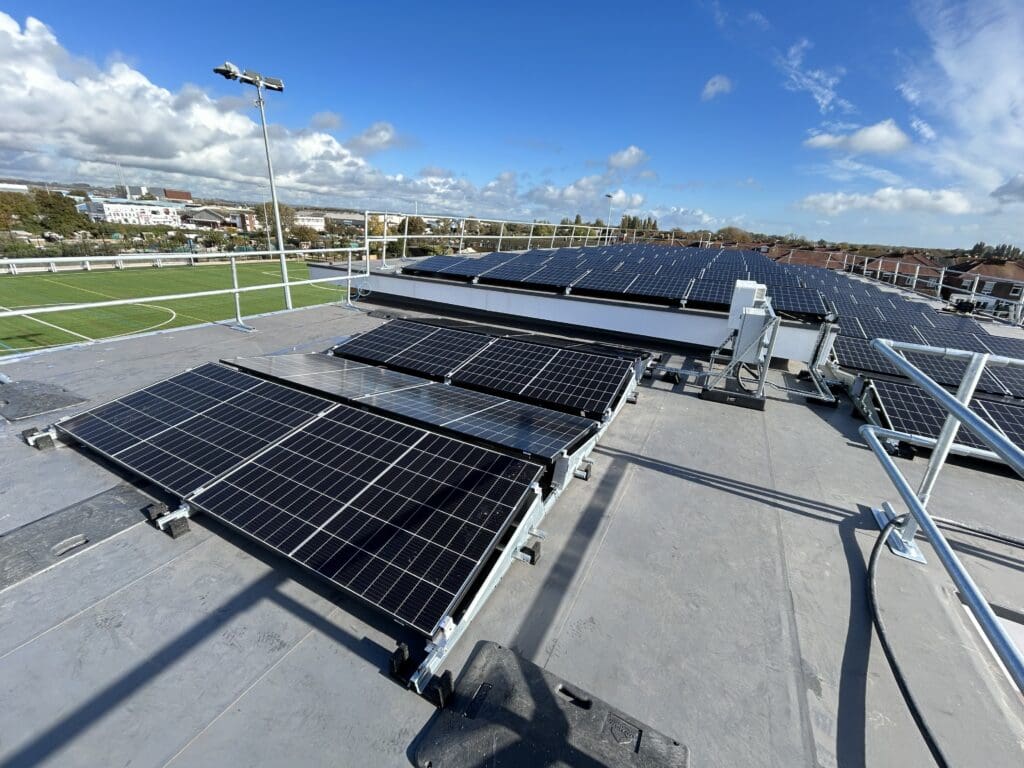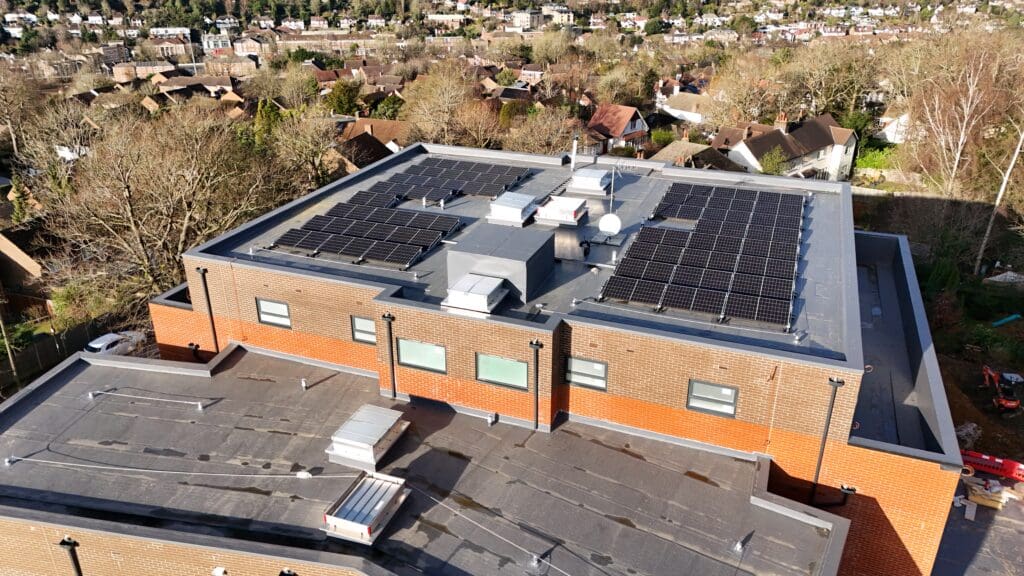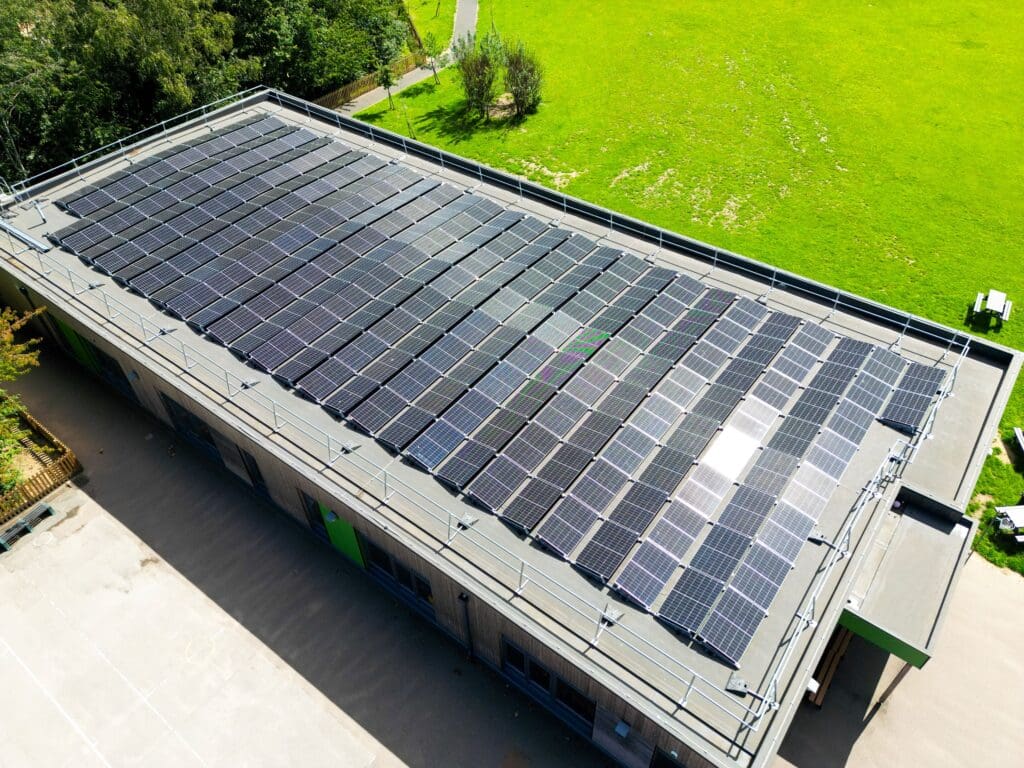A Guide to Flat Roof Solar Panels.
Published: 31/07/25
Introduction to Flat Roof Solar Panels
Solar panels are often thought of as a technology buildings can only benefit from on sloped roofs. On a south-facing sloped roof, the panels are exposed to more sunlight and therefore generate more electricity. However, for buildings with flat roofs, solar panels are still an option.
Typically, we install flat roof solar panels on commercial buildings, warehouses, and hospitals, but given the growing demand for commercial solar solutions, our in-house design team have assessed many flat roofs and found solar panel systems that work for them.
Benefits of Flat Roof Solar Panel Installation
Flat roofs are usually large underutilised areas, providing the perfect home for solar panels. They also give plenty of flexibility in panel layout and orientation that a design team can use to maximise their electrical output.
Another benefits of flat roof solar panels, is that they are easier to access and install on than pitched roofs. Flat roof systems can be installed much quicker because of this and therefore tend to cost less.
Flat roof solar panels are more commercially viable, as the installation causes minimal disruption to the building use. A business can run completely as normal throughout the installation, keeping revenue flowing.
All of the above lead to a faster ROI. Firstly, the system is cheaper; secondly, there is no revenue lost; and finally, in-house design teams like ours can tailor the system design to the needs of the business.
Commercial businesses also benefit from savings on their energy bills while using solar generated electricity, and tax reliefs can make the project even more viable.
Types of Flat Roof PV Panels
Monocrystalline vs. Polycrystalline
Monocrystalline solar panels are the most popular option for most businesses despite their higher price, as they are more efficient in all weather conditions. They are also more space-efficient than polycrystalline, and therefore a better choice for most flat roof systems.
Polycrystalline solar panels have the benefit of lower upfront costs for installation, and if your business has a large flat roof, space efficiency may be less important than starting capital.
Thin-Film Solar Panels
These are cheaper again, as they have a lower level of efficiency than both monocrystalline and polycrystalline solar panels, though they are more tolerant of shading. They are lightweight and flexible, which makes them better for older or more fragile roofs.
Mounting of Solar Panels
Now that you know what type of panel might be the most suitable for your project, you need to also consider the mounting of the solar panels.
Ballasted Systems
Ballasted systems do not require any roof penetration, which makes them suitable for flat roofs, as they protect against leaks and bad drainage. They work by holding panels in place with weights, and are quicker to install than other mounting systems. It also makes them idea for buildings with restricted planning requirements.
Fixed Tilt Systems
Fixed tilt systems do require roof penetration or frame anchoring as they do not use weight to hold panels down. They are integrated into your roof system so that they can be set at the optimal angle for energy capture, usually 10-15 degrees.
This mounting system for flat roof solar panels is usually very efficient, with panels set east and west-facing to maximise the roof space.

Factors Affecting Flat Roof Solar Efficiency
Panel type and mounting are not the only factors to take into account when deciding on a flat roof solar panel system. Here are some others and why they are important:
Angle and Orientation
As mentioned above, fixed-tilt systems can offer your business a viable option for energy generation that isn’t south-facing. While south-facing panels generate more energy from the sun, at a 15 degree tilt when put next to one another, they will shade other panels.
This is why east and west-facing panels are commonly used, as they are arranged in back-to-back rows and don’t require wider spacing to avoid shading. This way, there can be more of them installed on a roof to maximise energy output.
They are also preferable for businesses with high daytime usage, as regardless of the time of day they will be able to generate electricity.
Sun Exposure
For most businesses in the UK with flat roofs, daily and seasonal sunlight tracking is important. Often, your roof will have clutter such as air-conditioning units or chimneys, and it is necessary to know when these will shade which areas of the roof. This is helpful in determining what type of inverter would be best for your project.
We use irradiance modelling during the design phase to account for the intensity of sunlight, weather patterns, and seasonal changes. These all help determine how best to install your flat roof solar panels.
Obstructions
Obstructions on the roof also provide some issues. Air conditioning units, ventilation and skylights can shadow panels and block access for installation teams. Installers need to plan the layouts ahead of time to avoid any issues with maintenance access zones.

The Process of Installing Solar Panels on a Flat Roof
Preliminary Assessments
When installing solar panels on a flat roof, our team starts with a desktop and then an on-site survey to assess your roofs suitability for solar panels. We will look at roof condition, sun exposure and shading, and any obstructions, and tailor our design to maximise electrical output.
Following from our initial design, we will also conduct an assessment of how your business uses energy to find out what solar panel type and mounting would best suit your site specifically.
Structural Considerations
When working out what panels and mounting to use, or the amount of panels, the load-bearing capacity of the roof needs to be taken into consideration.
For ballasted mounting systems, wind uplift needs to be low, and the ballasted weighting needs to be enough that the panels don’t move around the roof. This can cause major fire and health and safety risks.
We also work with major roofing companies to install without compromising roof warranties. We’ve also worked in synchronisation with roofing companies while carrying out roof remedials and solar installations to keep costs down for our clients.
Installation
Our directly employed engineers will carry out the installation to design. Our health and safety officers, along with our quality managers, oversee the solar panel installation, making sure it is following specifications.
After Installation
We can set clients up with our remote monitoring, so if there is any dip in generation it can be diagnosed and fixed. Our maintenance team have one of the fastest response times in the industry as they are dedicated to operations and maintenance (O&M).

Frequently Asked Questions
Do flat roof solar panels require maintenance?
Solar panels do require maintenance, though it is minimal. An annual check of your electricals and regular cleaning improve their performance.
What is the average lifespan of flat roof solar panels?
Most solar panels generate energy for 25–30 years. Inverters typically last 10–15 years, but these can be replaced in a system when needed.
At Carbon3, we back our solar panel installations with warranties and 24/7 support.
Are there any regulations for flat roof solar installations?
Some flat roof solar panels will require planning permission. Other regulations include fire, wind loading, and structural certifications. Your installation must also comply with building regulations.
If this sounds daunting, Carbon3 can manage these regulations and requirements for you.
Can solar panels damage my flat roof?
No, when installed correctly, solar panels will not damage your roof. Ballasted systems avoid penetrations entirely, while mechanically fixed systems use waterproofing techniques. Carbon3 conducts structural and weatherproofing assessments as part of the design to protect your building fabric.
Can I add battery storage to a flat roof solar installation?
Yes. Battery systems can be installed alongside or retrofitted later. For flat roofs with adequate structural strength, Carbon3 can integrate energy storage on or near the roof for peak shaving, resilience, or grid services.
Why Choose Carbon3 for Your Flat Roof Solar Project?
We’ve installed thousands of flat roof systems across the public sector, social housing, and commercial buildings. Our in-house engineering and design teams ensure maximum yield, with the lowest lifetime cost.
Get in touch for a free flat roof solar consultation. Learn how much your company could save with a tailored Carbon3 solar panel system.